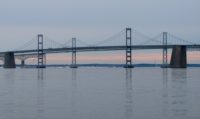The report notes that the decks are "considerably thinner than most decks built today, which typically have a minimum thickness of 8 in." It adds that the thin decks, flexibility of the longer spans and traffic load subject the spans "to higher than normal stresses, making it essential that the overlay functions as an integral part of the deck structure."
The panel also included an appendix with 21 highly specific recommendations for doing the overlay work, including a ban on applying matrix restorer or epoxy adhesive to the prepared deck surface and requiring the clean blasted surface should be wet down for at least one hour and kept wet for at least three hours before the overlay is applied.
The report observes that there inevitably are exceptions made to procedures on construction projects, but it adds, "In the case of the Bay Bridge, it appears that there were a particularly large number of exceptions and non-standard practices in a situation where meticulous adherence to best practice was a necessity for good results."
Elsewhere in its 66-page report, the review panel says all of the phase one overlays with known deficiencies have been replaced or will be by the end of the first phase, in spring of this year. But it adds that "sooner or later, the [Maryland Transportation Authority] will face the need to do full-depth replacement when the...



Post a comment to this article
Report Abusive Comment